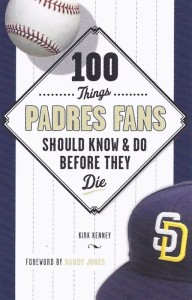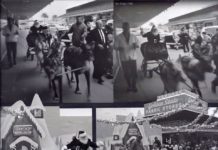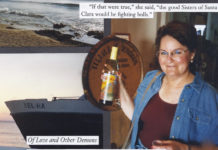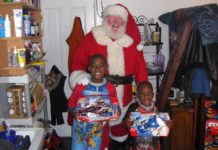
by Bill Swank
The 2016 Major League Baseball All-Star Game will be played next month at Petco Park.
Brown robes are traditionally worn by Franciscan Friars. When the 1969 San Diego Padres debuted in beige uniforms and brown caps, the color selection had nothing to do with the Franciscans. Team owner C. Arnholt Smith simply liked brown. The color scheme was mocked throughout baseball and many San Diegans didn’t like it either.
This year, the National and American League All-Stars will wear modern variations of brown and yellow jerseys during workout day and the Home Run Derby. Nostalgia smoothes the rough edges off the past.
In retirement, Tony Gwynn professed affection for the old brown uniforms he wore as a young Padre. He said, “I’m just an old-school guy who coaches college baseball, but, again, you’re talking about the only team in all of baseball that would wear brown.”
Here are some of the things I didn’t know until I read Kirk Kenney’s very enjoyable 100 Things Padres Fans Should Know & Do Before They Die The “things” are listed in order as they appear in the book.
- When Tony was drafted in 1981 by the Padres, he hated the brown and gold uniforms. This was two years prior to Steve Garvey’s memorable death sentence for the garish Padres uniforms when the fashion conscious first baseman complained, “I look like a taco.”
- Tim Flannery wore #6 before Garvey joined the Padres in 1983. Flannery was gracious and surrendered the number to Garvey. The former Dodger star was duly impressed by the gesture. The sartorially splendid Garvey told surfer Flannery that he’d buy him any suit he wanted. Flan wanted a wet suit. Garvey insisted on a $600 Ralph Lauren three-piece ensemble. Flannery wore it once on a team flight. Teammates Bruce Bochy and Goose Gossage threw buttered rolls at him and he never wore the expensive suit again.
6 (continued). When he was with the Phillies, former Padres outfielder Johnny Kruk traded his #28 jersey to newly acquired Mitch “Wild Thing” Williams for two cases of beer. [Since 1907, Harry Horton remains the only player in baseball history to have been traded for a bottle of beer.]
- Ted Giannoulas attended Hoover High School and his friends tried to convince him to tryout for the school’s Cardinal mascot. His response, “I’m way too hip to do anything like that. You guys really think I’m that stupid?” Later, in 1974, while a student at San Diego State, he got a job for KGB radio wearing a chicken costume handing out Easter Eggs at the Zoo. The rest is history.
- Tony Gwynn batted over .400 during a 162-game stretch that began August 1, 1993 and ended May 9 (his 35th birthday),1995. During that time, he hit .406… reminiscent of Ted Williams’ 1941 season.
- “Irascible, feistyandcrusty were words used to describe longtime Padres coach (Whitey) Wietelmann.” In 1986, there was a confrontation between Whitey and Peter Tork of “The Monkees.” Tork called Wietelmann an “old man.” The old man “cold-cocked” the singer who was scheduled to perform in a post-game concert. The show went on…
- Kenney briefly acknowledged “some controversy in 2001 when he (Dave Winfield) was enshrined in Cooperstown wearing a Padres hat.” At the time, the New York Daily Newsreported the Padres gave Winfield a $1,000,000 to wear “SD” on his cap in Cooperstown. The Padres denied this, but Winfield became a vice president in the organization. [Personally, I have always felt the honor of being the first Padre in the Hall of Fame should have gone to Tony Gwynn, who chose to spend his entire career in San Diego.]
- Reviewing deals made by “Trader Jack McKeon, Kenney noted the Giants got the best of the swap that sent Kevin Mitchell, Dave Dravecky and Craig Lefferts to San Francisco. [Left unsaid… Chris Brown flopped in San Diego, nobody remembers Keith Comstock, but the Padres did get 1989 Cy Young winner Mark Davis… and broadcaster Mark Grant.]
- At the end of his Hall of Fame career, Rollie Fingers was offered a contract to pitch for Cincinnati, but the Reds had a strict “clean cut” policy. Fingers said, “You tell (owner) Marge Schott to shave her Saint Bernard, and I’ll shave my mustache.” The dog, “Schottzie,” didn’t get scalped and Rollie retired.
- “Chip Bowers, a young kid in corporate sales” suggested “Hells Bells” should be played when Trevor Hoffman entered the game. Who is Chip Bowers? Today, he is Chief Marketing Officer for the Golden State Warriors.
- Tony Gwynn got his 3,000th hit in Montreal on August 6, 1999. Six years earlier, he smacked his 2,000th hit on the same date, August 6, 1993. August 6 was his mother’s birthday.
- The Padres are commended for honoring our military. Camouflage uniforms and Marine recruits in the right field stands are part of Sunday baseball in San Diego. The tradition dates back to the days when uniformed sailors would get off their ships and take a short walk across Harbor Drive to a wooden ballpark at the foot of Broadway. A lot of underage white caps enjoyed PCL baseball and cheap beer at Lane Field.
- Carlos Hadaway was a 19-year-old sailor at Naval Training Center when he drew the cartoon that became “The Swinging Friar.” Twice, he overcame blindness and numerous operations to become a respected Western artist known as “The Arizona Kid.” [Carlos remains upbeat, but he is currently facing serious health problems. It was awkward to tell him about his chapter in a book about things to know and do before you die. Triumph Books has a series of “before you die” books that include major league baseball, NFL and college football teams. It’s stupid title.]
- New Padres president (and former Dodgers general manager) Buzzie Bavasi planned to select “Bill Russell, Jeff Torber (Torborg), and Jim Brewer” from the Dodgers in the 1969 expansion draft. Walter O’Malley called Bavasi to advise that his replacement, Fresco Thompson, was dying of cancer. Buzzie visited his old friend in the hospital and agreed not to draft Russell, Torborg and Brewer. At Thompson’s request, he took Al Ferrara, Jim Williams and Zoilo Versalles.
- Kenney gives a brief history of the 1909 Western Metal Supply building which serves as the left field foul pole at Petco Park. He wrote, “It was filled with metal products for wagon makers, blacksmiths, and others.” Not every supply sold at Western Metal was metal.

This 2004 photo shows my niece, Cid Kovalesky, holding an enlarged Western Metal advertisement from a 1936 San Diego Padres scorecard. The Western Metal building and left field foul pole are in the background. The verbiage reads, “The Official Ball Used By The Pacific Coast League is Manufactured by the Wilson Sporting Goods Co., District Agent, Western Metal Supply Co., San Diego.” In the years before PCL baseball in San Diego, Western Metal always sponsored teams in the local sandlot leagues.
- In 1971, shortstop Enzo Hernandez tied the record for fewest runs batted in for a season (12) set in 1907 by Pittsburgh outfielder Goat Anderson. During his rookie season, Hernandez only managed 12 ribbies in 549 at-bats, but nobody remembers his anemic bat. They only remember public address announcer John DeMott’s dramatic introduction, “NumberElevenEnzooooooHernandezzzzzz.”
The “good field-no hit” Hernandez played six seasons for the lowly Padres. Those teams were incredibly terrible, but nostalgia helps smooth the rough edges off the past…
Father’s Day is coming up. Apologies to mothers (like my wife) who don’t understand this review, but Dad would like this book.




